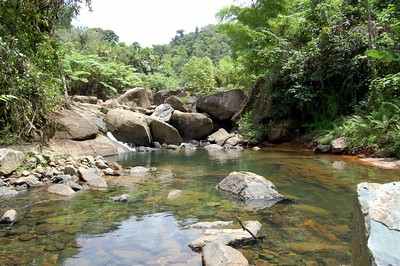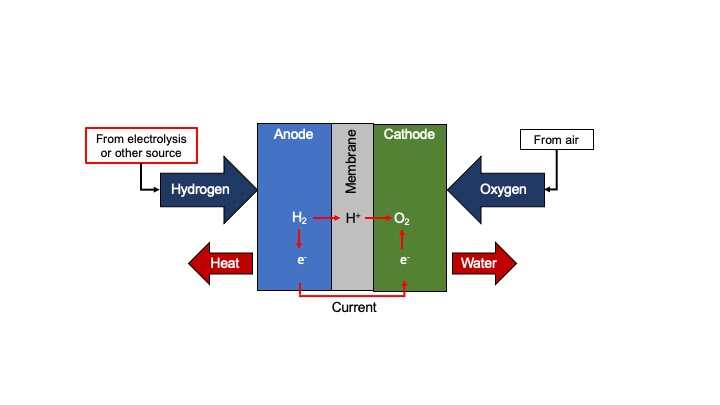5 Abiotic Factors in the Rainforest and Their Attributes
Abiotic factors in the rainforest are; solar radiation, rainforest-soil, atmospheric gases, water, and physicochemical parameters.
This study discusses abiotic factors in the rainforest and their characteristics, as follows;
1). Solar Radiation (as one of the Abiotic Factors in the Rainforest)
Solar radiation is one of the most important abiotic factors that occur in the rainforest.
It can be described as electromagnetic waves from the Sun, and comprises of both light and thermal energy in the form of visible light rays and infrared, respectively [3].
The importance of solar radiation is based on the fact that it is the primary source of energy to rainforests. Energy from solar radiation is captured by plants (and other autotrophic organisms) and converted to bioenergy through photosynthesis, which is then transferred through feeding to heterotrophic organisms in other trophic levels of the forest food chain.
By virtue of the near-equatorial geographic position, rainforests receive relatively-large amount of solar radiation on a timely basis, compared to other terrestrial ecosystems.
Solar radiation can be viewed as the core basis of energy-transfer in rainforests, as well as the ultimate bridge between biotic and abiotic factors, because it is the raw material required to produce chemical bioenergy and biomass which are essential toward the sustainability of rainforests.
It must be acknowledged that solar penetration is low in forests, because of the dense nature of the forest structure; which is characterized by a vegetative canopy and understory.
Most sunlight is intercepted and absorbed by tree-leaves in the upper canopy layer, and facilitates the massive growth of these plants. On the other hand, solar radiation reaching the forest floor is relatively low, as most of it is blocked by overgrowth that serves as shade to soil and organisms at ground level.
Solar radiation plays a major role in biological processes in the rainforest, such as organic adaptation.
Forest plants adapt to environmental conditions like the availability of sunlight for photosynthesis. Low-height plants like shrubs and grasses survive by conserving nutrients to enable them function effectively with less sunlight than trees.
Vines and lianas utilize their flexible stems to grow around tree stems toward sunlight [4].
Nocturnal and diurnal organisms are also regulated by solar radiation, which they use as an indicator for their hunting, hibernation and breeding activities.
Photosynthetic processes are linked to carbon sequestration and oxygen production from plants. This means that solar radiation plays roles in the carbon and oxygen cycles of rainforests.
Lastly, the availability of sunlight in various zones and segments of the rainforest establishes distinct niches called micro-habitats. These zones support rainforest species according to their tolerance levels and need for solar radiation. The end-result is a facilitation of increase in species richness and biodiversity of the ecosystem.

2). Rainforest Soil
Soil is an abiotic factor because it comprises mainly of minerals and nutrients, which are inorganic in nature.
However, the overall complexity of the soil is high. It can be described as an ecosystem of its own, comprising of diverse organisms, physicochemical conditions and resources.
In the rainforest, soil is particularly rich in its ecology, and important in its role as a natural resource and storage system
The composition of rainforest soil includes high concentration of organic matter from animal and plant sources. This organic content is behind the dark coloration of forest soils, which are rich in humus from the biodegradation of organic materials.
Other sedimentary particles like silt, clay and sand also occur in forest soil.
The rainforest soil can be studied as a cross-sectional profile of layers. It is overlain by organic matter that is mostly from plants, and in the form of fruits, twigs and fallen leaves; as well as remains and waste of animals.
Processes like erosion and leaching do occur in rainforest soils, but are less-pronounced because the dense vegetation serves as a protective covering from agents of erosion like water and wind.
Lastly, rainforest soil is abundant with microorganisms like bacteria and fungi; and their activities that lead to the recycling and storage of essential elements. Also, many of the physicochemical parameters in rainforests can be measured from soil samples.

3). Atmospheric Gases (as one of the Abiotic Factors in the Rainforest)
Atmospheric gases constitute a versatile abiotic factor in the rainforest, and exert influence over climatic, biological and physicochemical conditions of the environment.
Life forms in rainforests depend on atmospheric gases for their survival and metabolism.
The most important groups of atmospheric gases in the rainforest are; oxygen (O2), carbon dioxide (CO2), nitrogen (N2), water vapor (H2O), and trace gases.
Oxygen and carbon dioxide are arguably the two most (biologically) important atmospheric gases. Because rainforests have a huge population of autotrophs (represented mostly by plants), oxygen is fairly abundant.
It is generated as a byproduct of photosynthesis, which consumes carbon dioxide as an essential raw material in the process.
Animals and plants depend on oxygen and carbon dioxide respectively, and these gases are recycled largely from their metabolic activities.
Nitrogen is the highest gas by proportion in the atmosphere, accounting for over 70 percent of an average sample of air [2]. It can be stored in rainforest soil as an important nutrient for plant growth, as a result of microbial processes and activities summarily referred to as nitrogen fixation.
Water vapor is a transient atmospheric gas that occurs by reason of the evaporative tendency of liquid water. In the rainforest it is relatively abundant, due to high rates of precipitation. Water vapor is directly indicative of atmospheric humidity, which a physicochemical (abiotic) parameter in the rainforest.
Trace gases are atmospheric gases with less volumetric and functional importance as the main gases like oxygen and carbon dioxide. Examples of these gases are; ozone (O3) and methane (CH4), which can be generated from natural processes occurring in the rainforest, like decomposition.
Generally, air quality is good within the rainforest, due to the air-filtering, oxygen-producing functions of plants, and the low prominence of human-environmental impacts in many rainforests compared to other areas, like urban ecosystems. The absence of air pollution and unfavorable atmospheric conditions in most parts of the forest enables its biodiversity to thrive.
4). Water
Like air, water is an essential abiotic factor in the rainforest, and is necessary for all forms of biological and physicochemical continuity.
The main source of water to the rainforest is precipitation.
Precipitation is relatively high in rainforests, so that annual rainfall ranges between 1,500 and 3,000 millimeters on average (although some studies report maximum threshold values of 2,000, 2,500, and 3,000 mm among others) [1]. As a result, the environment is fairly humid, all year round.
Because solar radiation is also abundant, the rainforest boasts of an active hydrological cycle, with continuous trends of evaporation, cloud formation, and precipitation. In fact, the active nature of rainforest hydro-cycles, influences regional climates significantly.
Rainforests also play host to aquatic ecosystems like lakes and ponds, which form microhabitats within the forest. These water bodies are storage grounds for water on the surface, and receive constant recharge from rainfall.
Summarily, the roles played by water as an abiotic factor in the rainforest include; climate regulation, nutrient cycling, biodiversity facilitation, and plant growth-pattern control.

5). Physicochemical Parameters (as one of the Abiotic Factors in the Rainforest)
As their name implies, physicochemical parameters are quantities or variables that influence the physical and chemical conditions of their environment.
In the rainforest, important physicochemical parameters include; humidity, pH, temperature, and nutrient availability.
These parameters affect climate, biochemical processes, and general productivity of the rainforest.
They are linked to other abiotic factors, and immensely useful when analyzing rainforest characteristics.
Conclusion
Abiotic factors in the rainforest are;
1. Solar Radiation
2. Rainforest Soil
3. Atmospheric Gases
4. Water
5. Physicochemical Parameters
References
1). Balogun, L.; Ayodele, O.; Oyerinde, O. (2019). "Analysis of Climate Change in Rainforest Ecosystems of Southwestern Nigeria." Available at: https://www.researchgate.net/publication/339784865_Analysis_of_Climate_Change_in_Rainforest_Ecosystems_of_Southwestern_Nigeria. (Accessed 31 May 2023).
2). Hu, J. (2018). "Human Alteration of the Nitrogen Cycle and Its Impact on the Environment." IOP Conference Series Earth and Environmental Science 178(1):012030. Available at: https://doi.org/10.1088/1755-1315/178/1/012030. (Accessed 31 May 2023).
3). Sterhov, А. I.; Loshkarev, I. Y. (2019). "Determination of the proportion of natural light in solar radiation using the method of conversion of lighting units into energy." Journal of Physics Conference Series 1353(1):012002. Available at: https://doi.org/10.1088/1742-6596/1353/1/012002. (Accessed 31 May 2023).
4). Wyka, T.; Zadworny, M.; Mucha, J.; Zytkowiak, R.; Nowak, K.; Oleksyn, J. (2019). "Species-specific responses of growth and biomass distribution to trellis availability in three temperate lianas." Springer, Trees 33(3). Available at: https://doi.org/10.1007/s00468-019-01828-3. (Accessed 31 May 2023).






